Here are some quick reviews of all the new games I’ve been playing lately. You can see the full A-Z list of past reviews HERE.
I am using the following Board Game Geek rating guide to give these a score on how much *I* like these games, but all this is just, like, my opinion, man:
- 10 – Outstanding – will always enjoy playing.
- 9 – Excellent – very much enjoy playing.
- 8 – Very good – enjoy playing and would suggest it.
- 7 – Good – usually willing to play.
- 6 – Ok – will play if in the mood.
- 5 – Mediocre – take it or leave it.
- 4 – Not so good – but could play again.
- 3 – Bad – likely won’t play this again.
- 2 – Very bad – won’t play ever again.
- 1 – Awful – defies game description.
With that in mind, here are the most recent games I’ve reviewed!
Adult Games
- 5 Minute Marvel (7.5) – A Marvel-themed version of 5 Minute Dungeon, this improves on the original by adding a small deck of special cards for each character (of which there are plenty to choose from!) The special cards give a welcome bit of both flavor and strategy, and each deck plays quite differently. The jokes in the villain deck wear out just as quickly as the original, but the game-play remains reasonably diverting.
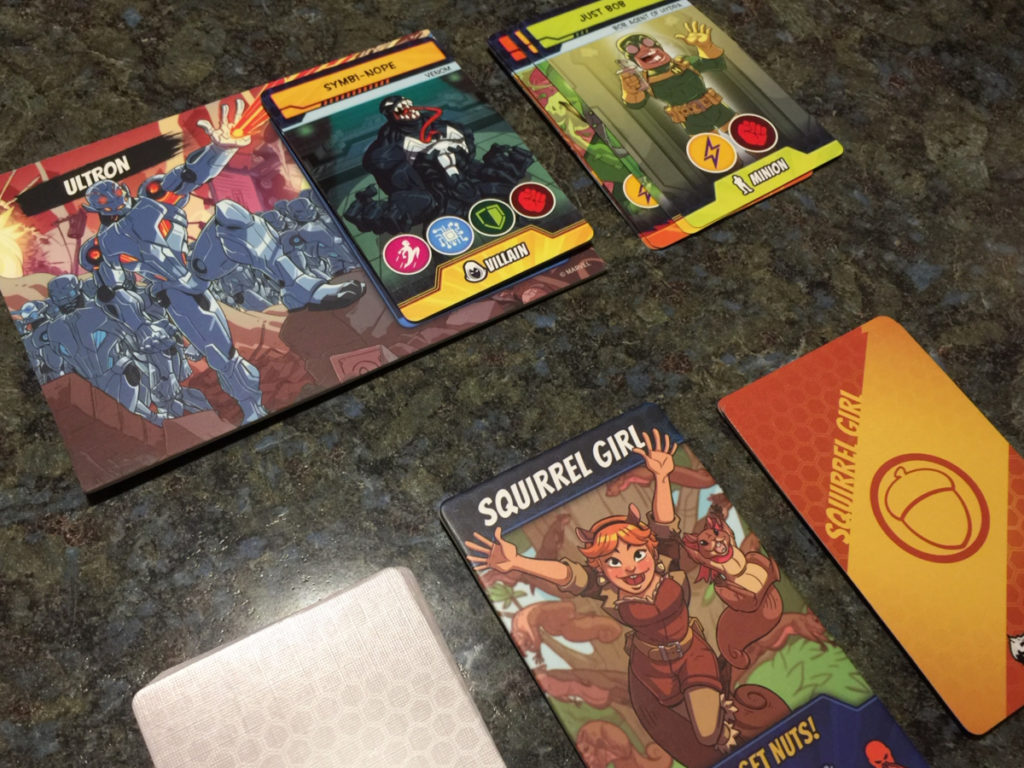
- Age of War (Risk: Express) (7.5) – This is a feudal Japan re-theme of the original Risk: Express, but the core game-play remains the same. It’s the usual game of Yahtzee style rolling and rerolling, but with plenty of good decisions by giving you lots of options for which card to go for.
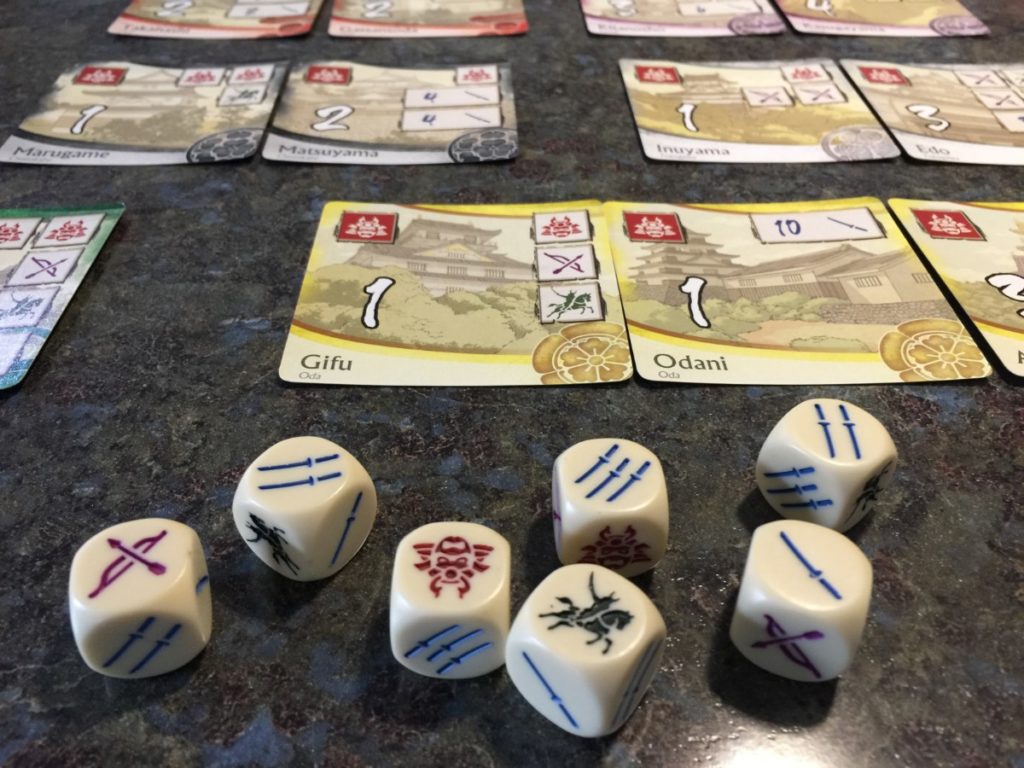
- Android: Mainframe (8.5) – Based on an abstract area-enclosure game, this adds on a “Hackers trying to take over sections of a super computer mainframe” theme reasonably smoothly. It’s a good, quick game set in the Android universe, though too often it can come down to the winner being whoever wins a push and pull battle of attrition over what cards come up. Also, the special cards each hacker gets vary WIDELY in power levels.
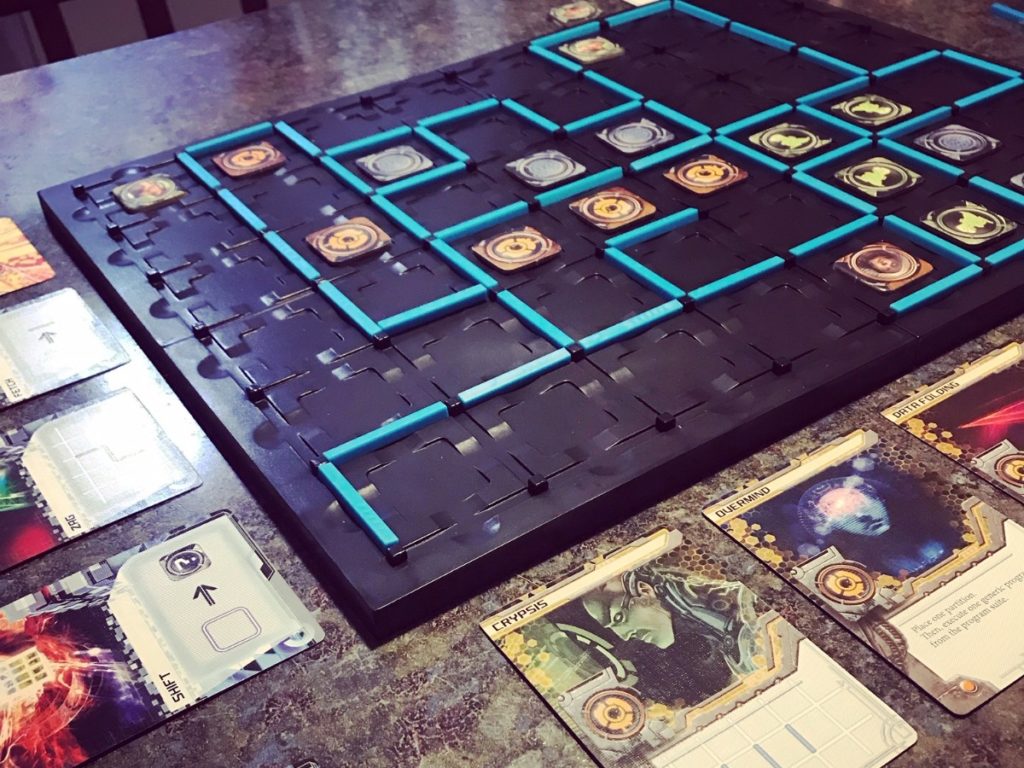
- Battleship Express (6.5) – This has very little to do with the actual Battleship game, instead it’s a Yahtzee style dice game where you pick a ship and roll its allotted assortment of dice to try to take out opposing ships. Special powers keep things interesting (I’d recommend the advanced rules), even if it does all feel pretty random (and some ships definitely have better odds to hit than others).
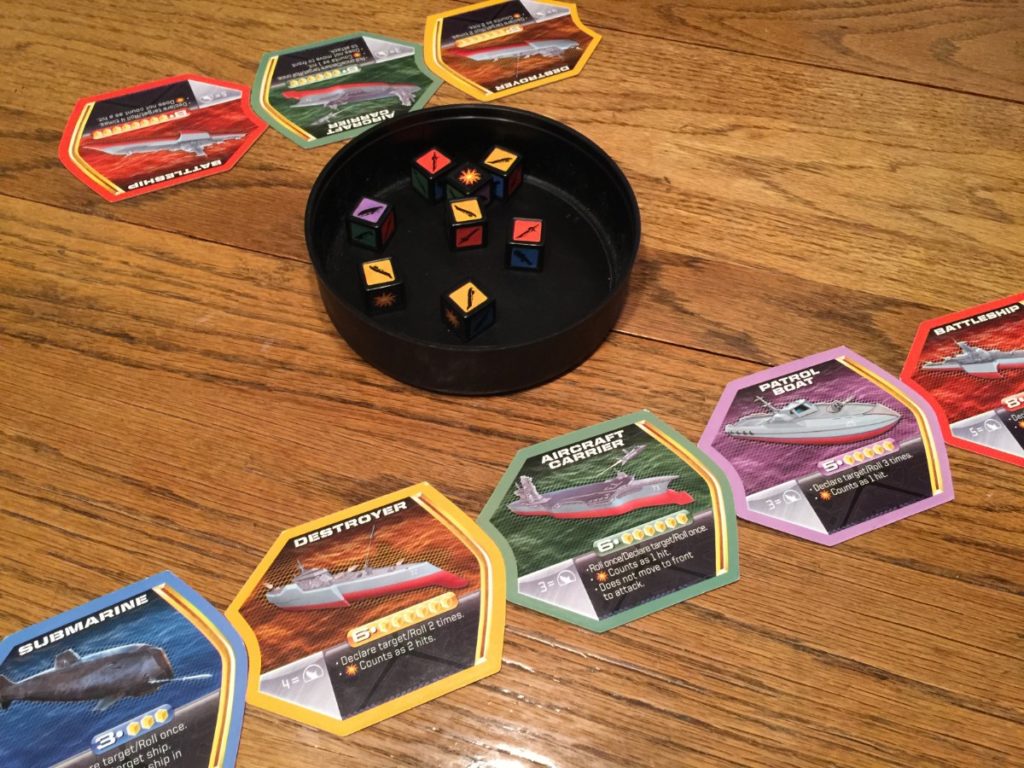
- Blokus: Duo (7.5) – The two player rules for regular Blokus aren’t great (basically you each just play two colors), so this smaller board designed for two only is a welcome change. The compact box that actually fits on your shelf is appreciated too.
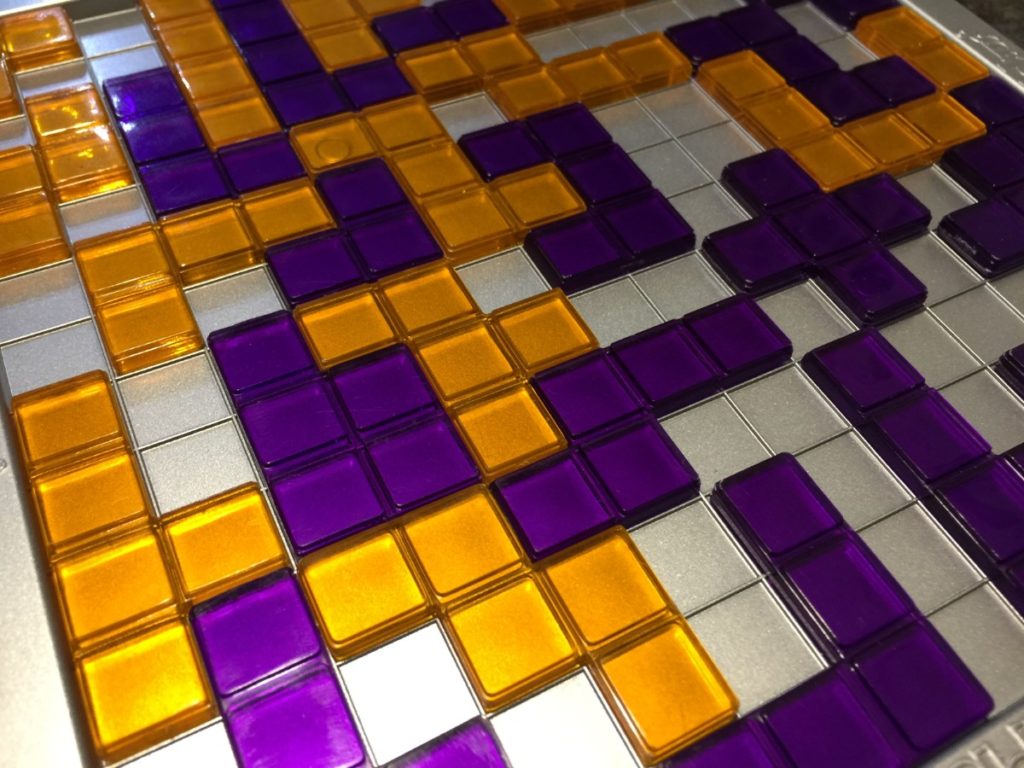
- Blokus: Trigon (7.5) – Blokus, except with triangles. The game remains just as engaging (though, perhaps a bit trickier to visualize due to the hexagonally branching vertices) with each turn bringing a great decision making trade-off between furthering your own territory and blocking your opponents (also this plays 3 far better than regular Blokus).
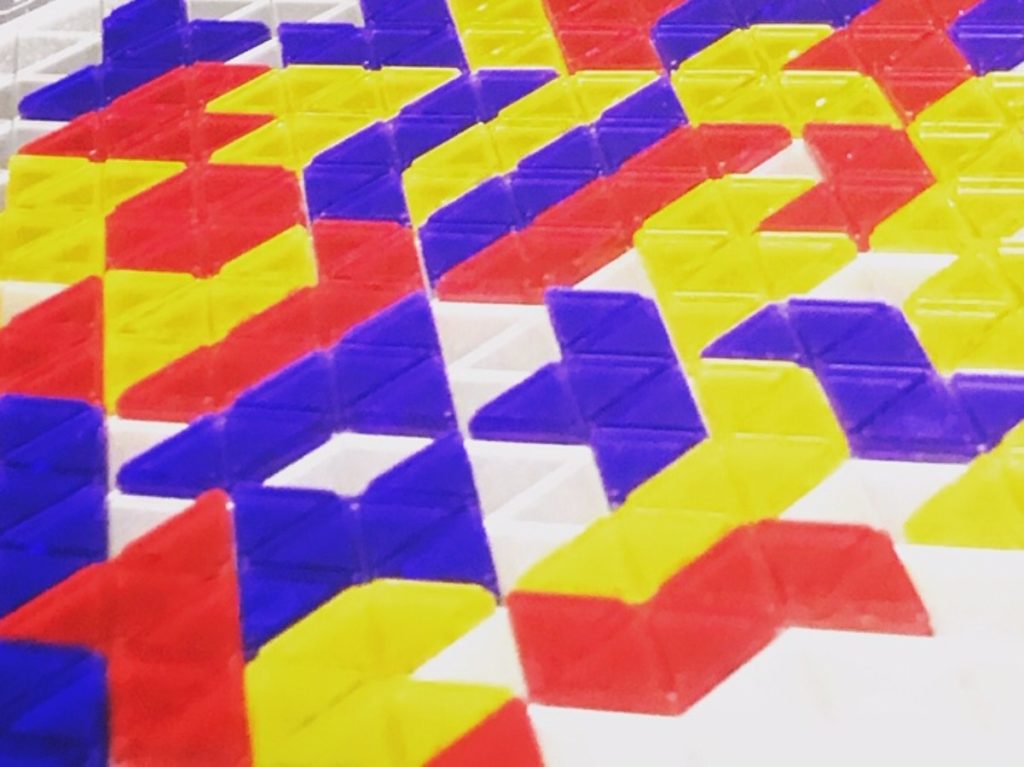
- Brothers (8.5) – So simple that it will make you say “that’s it?” when you realize that all you do is take turns assembling a field, and then take turns placing as many of your fences (L-shaped for one player, straight for the other) into the enclosure as you can. It actually ends up being a fun (and super quick) little spatial game with lots of agonizing decisions over how best to cut off your opponent. As with most abstracts, experienced players will have a strategy edge (to some degree, I am still working on figuring out best strategies), but this ended up being more fun than I thought it would be (I initially bought it mostly due to the Krosmaster universe theme).
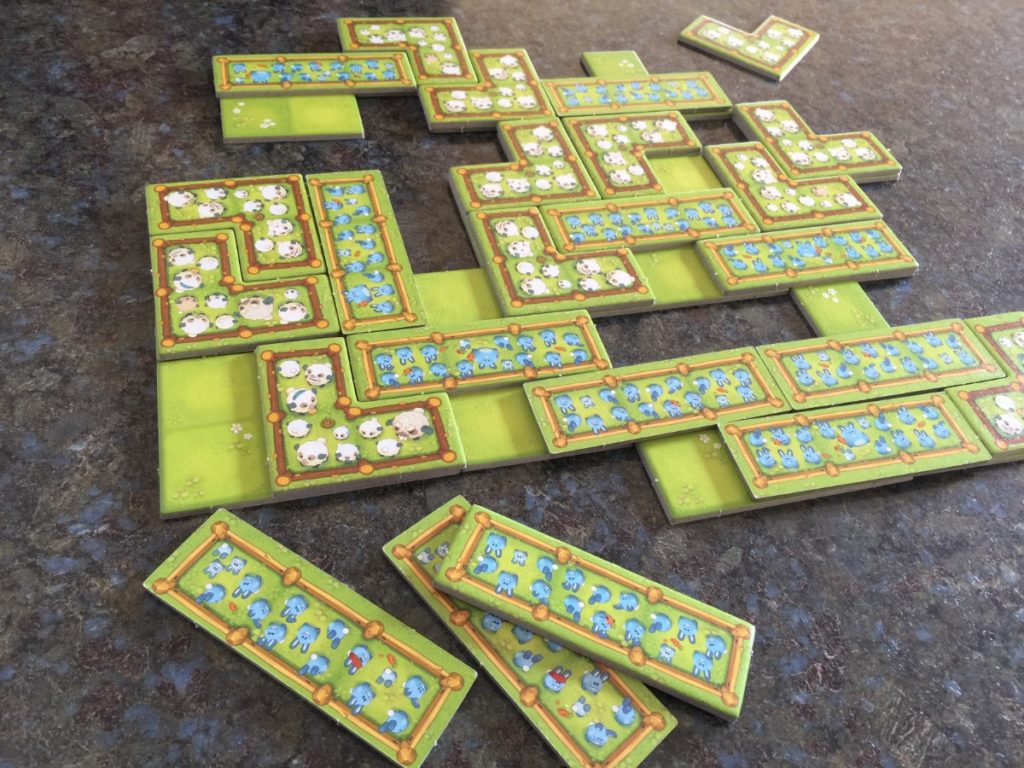
- Checkers (5) – Pure strategy games like this never get me very excited to play as it seems like I’d have to spend far more time with the system than I want to even get a coherent system of game play going. I suppose it could be fun setting up elaborate traps that involve multiple jumps, but at the end of the day there is just way too much other stuff out there that I’d rather be playing.
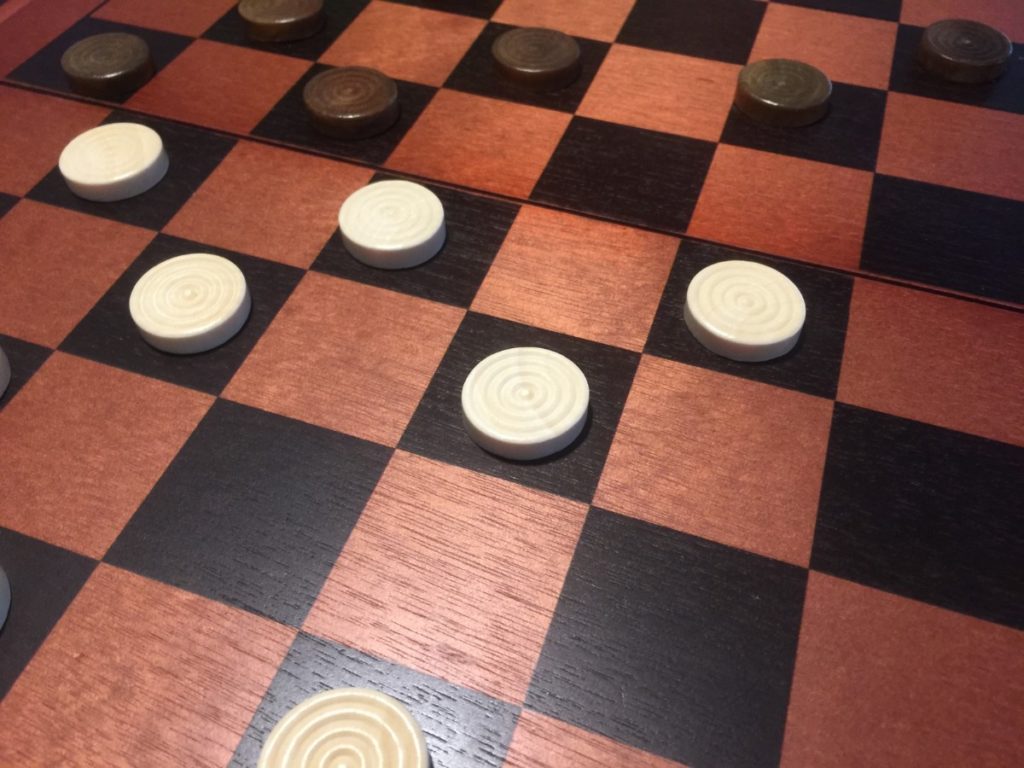
- Choose Your Own Adventure: House of Danger (7) – Despite the dice, the equipment cards, and the Psychic Scale/Danger meter this is just a Choose Your Own Adventure book printed on cheap cardstock. As such, it’s a fun enough diversion, but it also suffers from the biggest weakness of the official books…your decisions have very little logical bearing on the overall story. Sure, rushing a deadly ghost will probably get you killed, but just about every other decision in the game is a crap shoot (and the ability to “go back” and try all the choices you skipped before moving on to the next level feels off too).
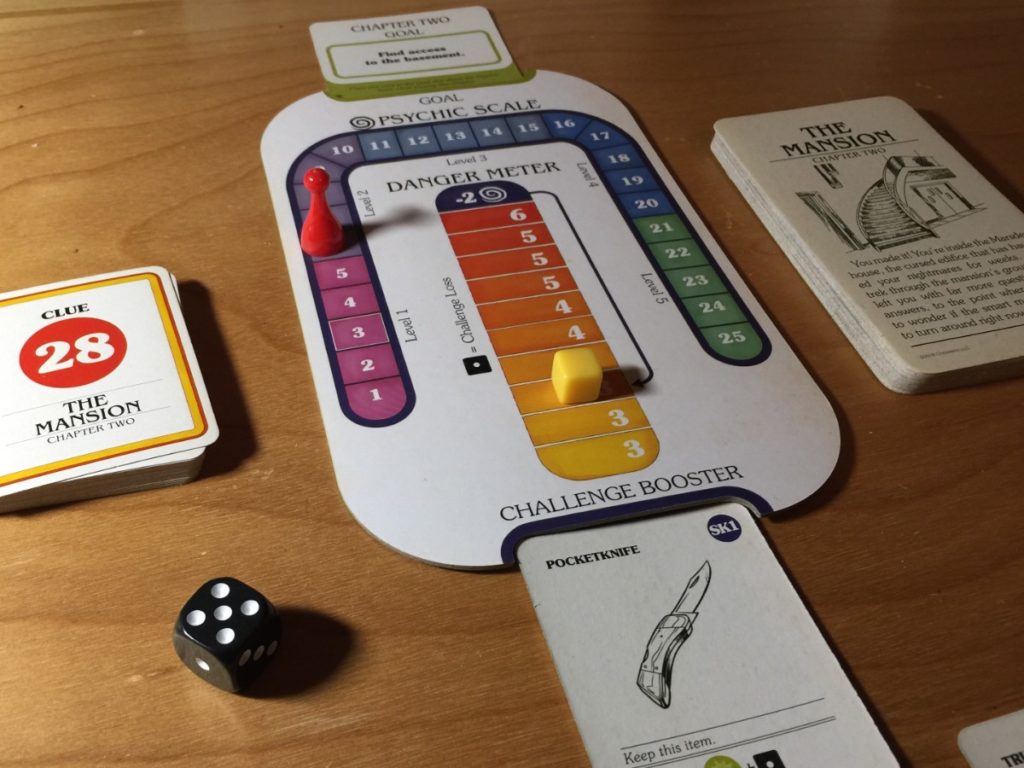
- Claustrophobia (9) – The beautiful cave tiles combined with decently pre-painted miniatures make this one of the best looking tactical combat games out there. The asymmetrical gameplay is quite simple (if you can get past a few chromey additions) with the demon player using dice to maintain a never-ending horde of imps (bolstered by a rotating big-bad) to keep the heroes from reaching their objective. The use of dice is actually quite clever (heroes must choose between boosting defense or attack strength each turn depending on the circumstances), and the game plays quickly, making this an easy repeat play for me.
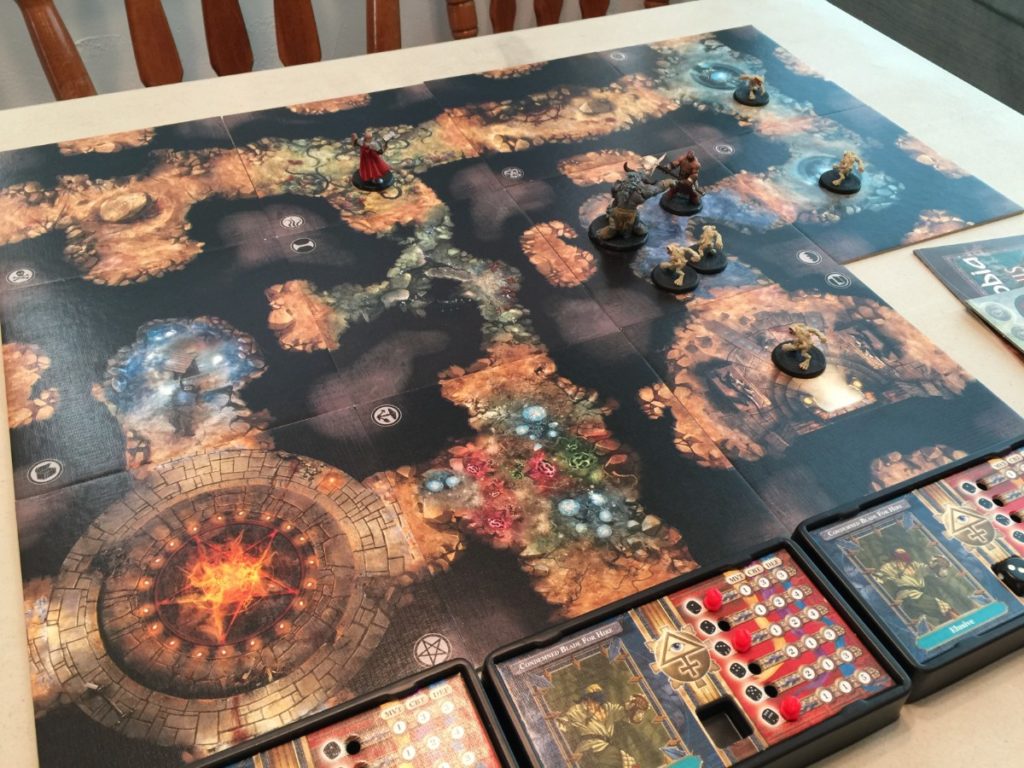
- D-Day Dice (8.5) – A Yahtzee style dice game with more special powers than you can shake a demolition charge at. The basic game involves rolling dice to get soldiers (lost each turn of the game…if you get to zero, you lose), courage (to move up the game board), specialist stars (to buy permanent upgrades), and tools (to buy one use upgrades). Each map is its own “puzzle” and you have to figure out the best combination of upgrades (reroll dice, exchange dice, etc) to use. It can be a lot to keep track of, but is quite fun (and even reasonably evocative of the theme), and, sometimes to its detriment, quite punishingly hard at later levels.
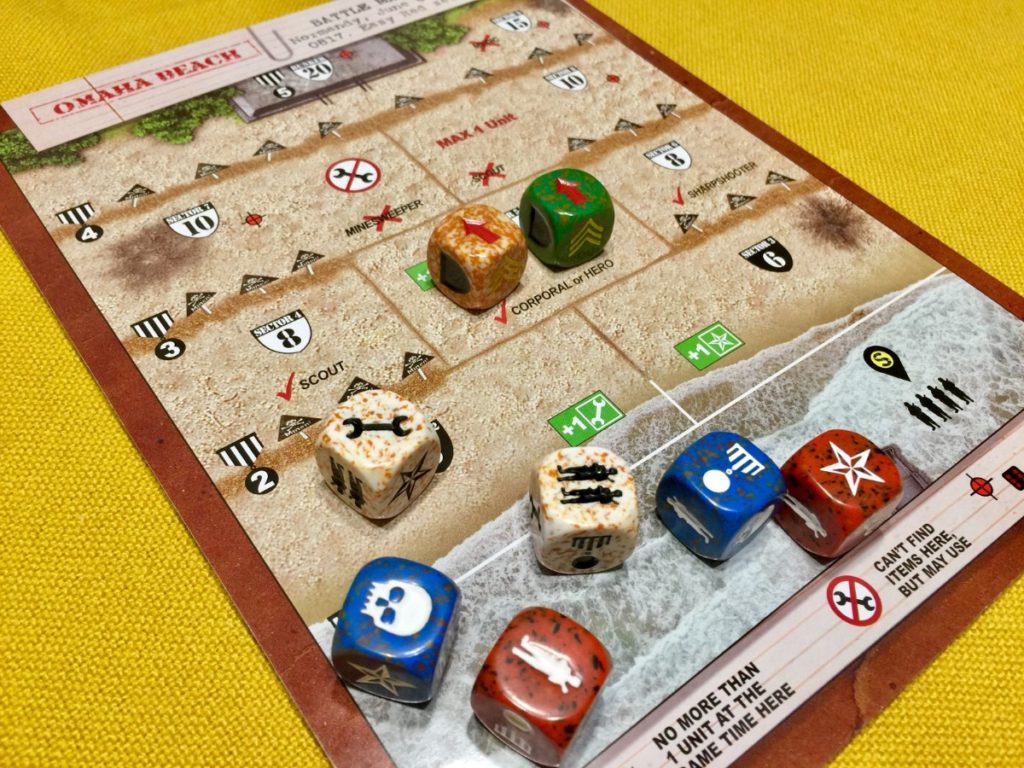
- Dungeons & Dragons: The Legend of Drizzt (6) – These D&D games are all pretty much the exact same game–each turn you have to choose between exploring and attacking monsters currently on the table (sometimes you can do both with the right positioning). Exploring new tiles gives you a new monster to add to the horde, not exploring forces you to draw an encounter that hurts your team. That’s really all there is to it, and, as the adventures go on, I find my interest in the system waning right at the point where everything starts to bog down in the book keeping of the final battle. This Drizzt version adds a few cool new rules, but nothing that really saves the game for me.
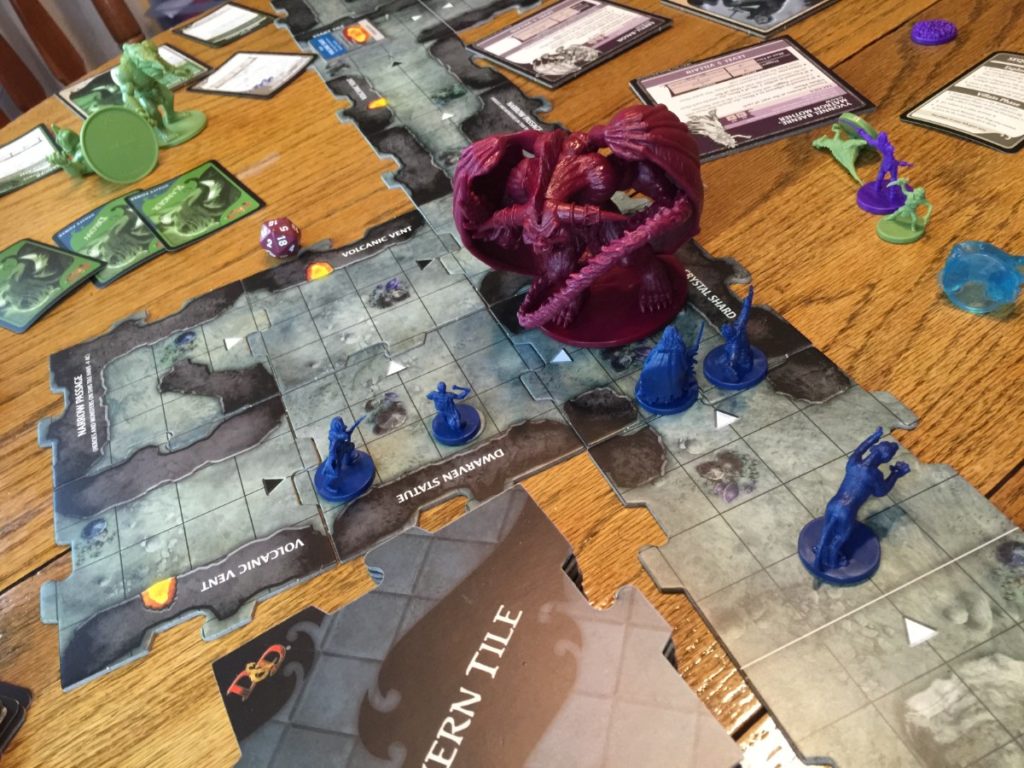
- Evolution: The Beginning (8.5) – Very good simplified version of the basic Evolution game. Each turn you basically have to decide whether or not to focus on making carnivores to hoover up food (victory points) or protect your herbivores. It actually has a nicely thematic feel to it, and makes for a surprisingly cut-throat two player game. If you play this seriously, you’ll be in for a nail-biter!
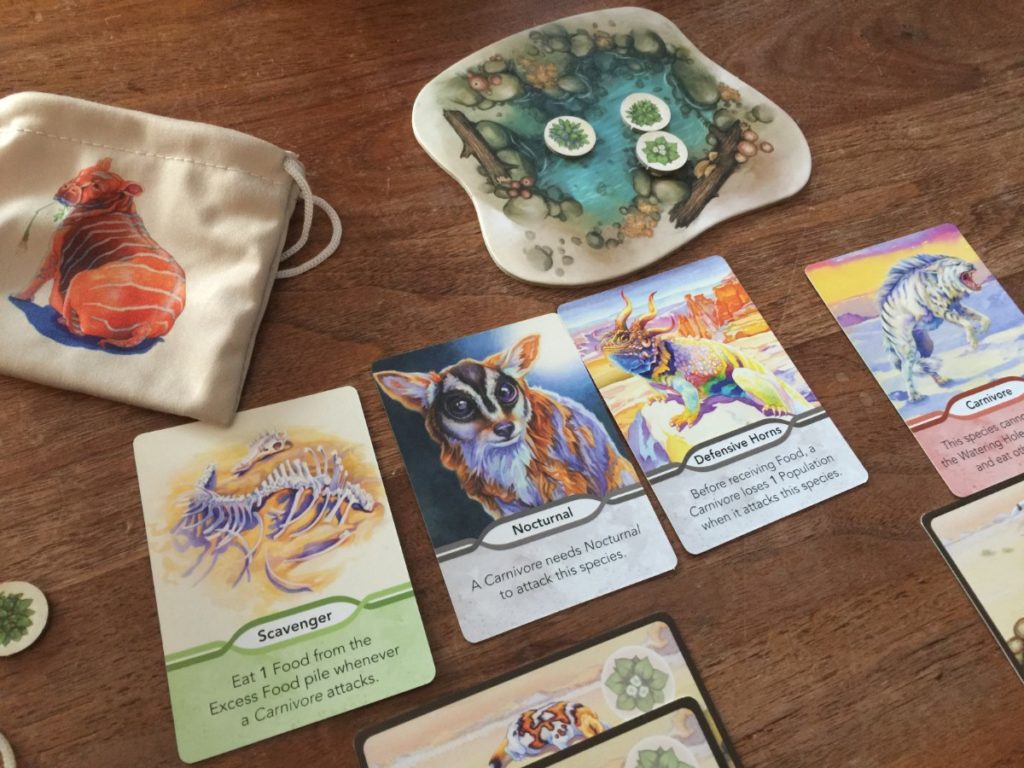
- Hearts (8) – In this, perhaps the most famous (and simplest) of all trick taking games, everyone plays one card in turn, high card wins the pot. The twist is you don’t want to collect any hearts (and must play a card of the suit led if possible). A great game, but not something I play a whole lot due to the glut of fantastic modern trick taking games that are out there.
- Hop! (6.5) – This is a ridiculous 3D board with even more ridiculous pre-painted chibi miniatures…all of which serves as a scoring mechanism for a simple game of tossing a foam rainbow ring and trying to get another player to catch it on their finger. There is a deck of cards to vary up the tossing and catching (sit on the floor/toss over your back/etc) and it’s fun enough, but this has to take the grand prize for needless over-production.
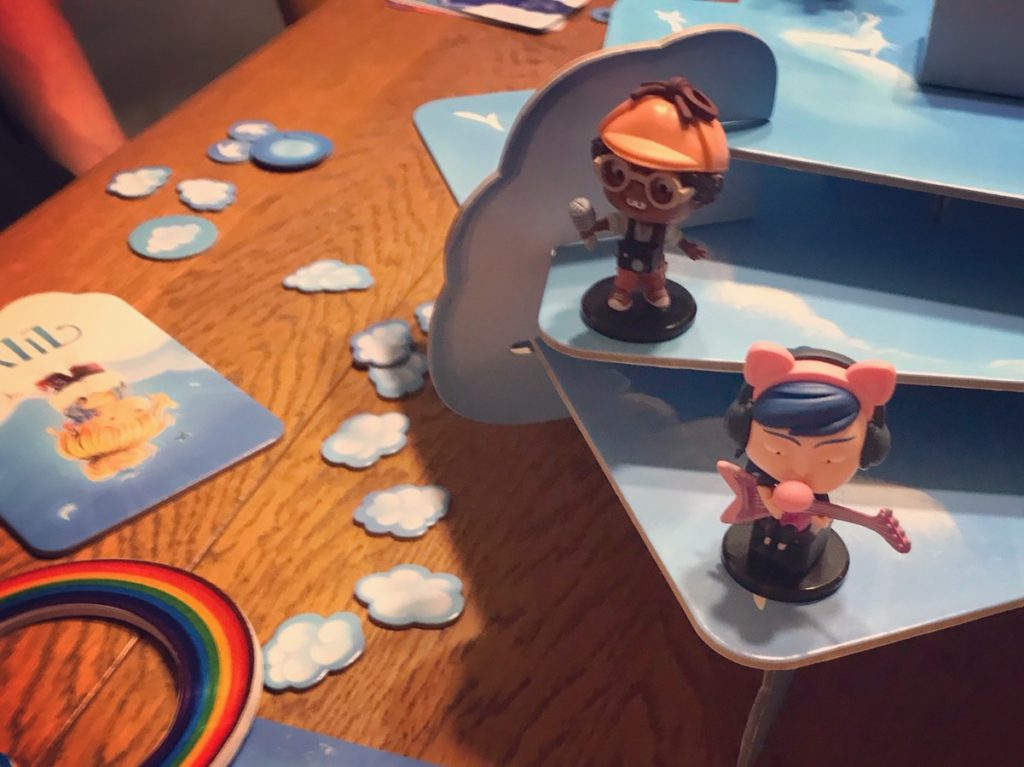
- Kings on the Corner (5.5) – Simple solitaire card game where players try to play out their hand by putting cards in descending order with alternating colors. There really isn’t any decision making in games like this, but it says something to the inner OCD in all of us that putting chaotic systems into order is so inherently satisfying anyway.
- The Lord of the Rings: The Duel (7) – This is actually pretty cool little tug of war game where you take turns playing cards doing damage in one of four rows that your opponent will attempt to block with the left side of his next card (that also deals the next set of damage on the card’s right side). There are a few special powers, and each round you set 3 cards aside for the fourth and final round giving a nice “drawback now for benefit later” bit of strategy to the game. The biggest flaw here is that it all feels like it’s on rails…if someone attacks you on all four rows, typically you will want to defend with all four rows, which can at times make it feel like the game is playing itself.
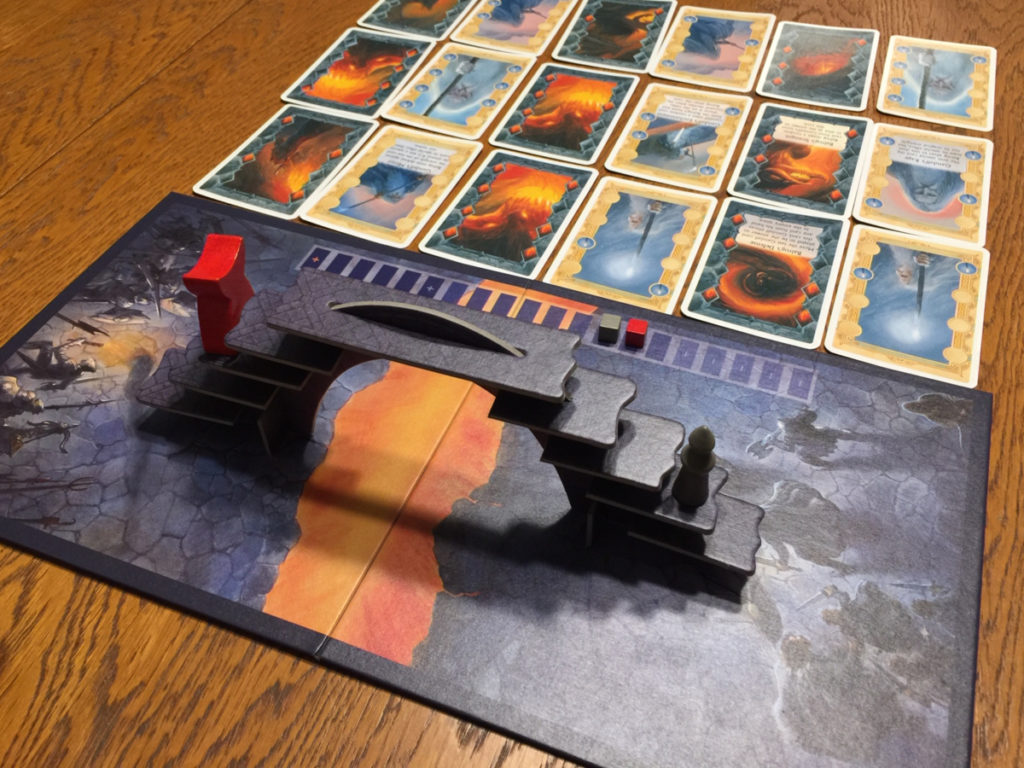
- Middle-earth Quest (8.5) – Great adventure game set in Middle-earth between the times of The Hobbit and The Lord of the Rings with generic hero characters travelling around and attempting to foil Sauron’s various between-books plots and machinations. There is a great adventure game here, with innovative movement/combat, lots of encounter cards, and a fun (though punishing if you make a misplay) Sauron player side for one player to take. Normally, all of this would rate the game a ten, but, unfortunately, the game seems to usually end in a tie, and the tie-breaker is a totally crap-shoot final battle that just feels deflating after investing a couple hours in something that basically ended up boiling down to a few quick rounds of cardplay.
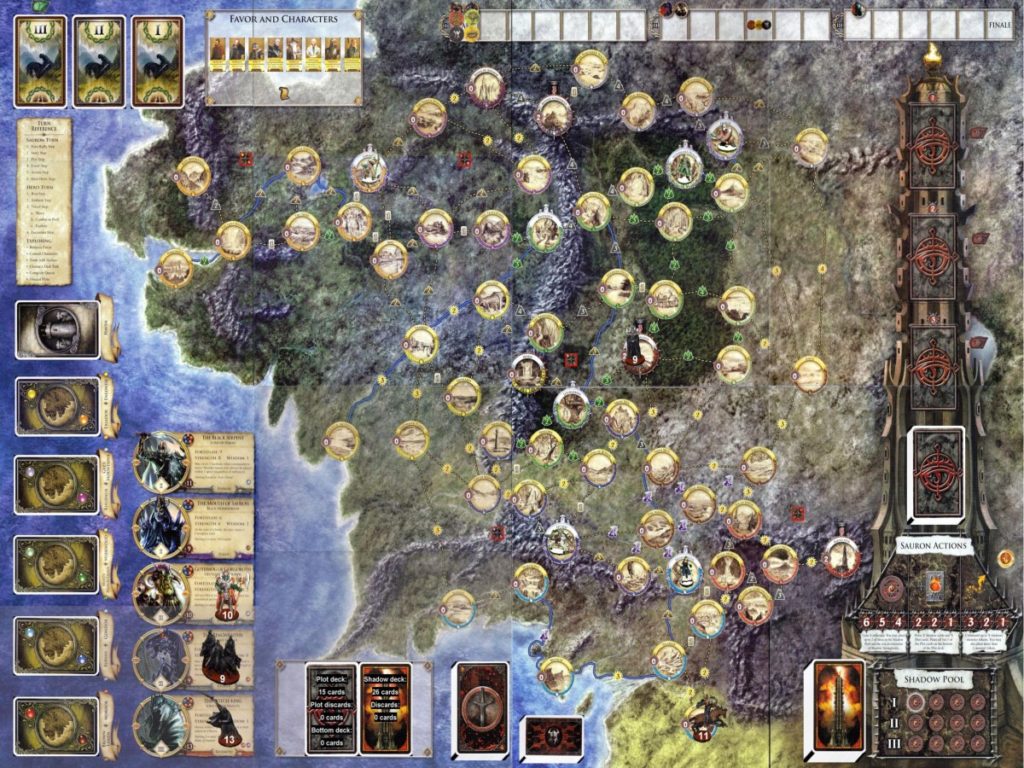
- Mölkky (9) – Fantastic yard game where you toss a wooden cylinder into a stack of numbered cylinders (resetting them where they land after each toss). The twist is that you get points for the total number of cylinders you knock down, OR, if you only knock down a single cylinder, you get the number printed on the cylinder (from 1-12). The other twist is that your team needs to get EXACTLY 50 points, going over loses you 25 points. All of which makes a nice trade-off between aiming for the single block you need, or trying to hit groups of blocks.
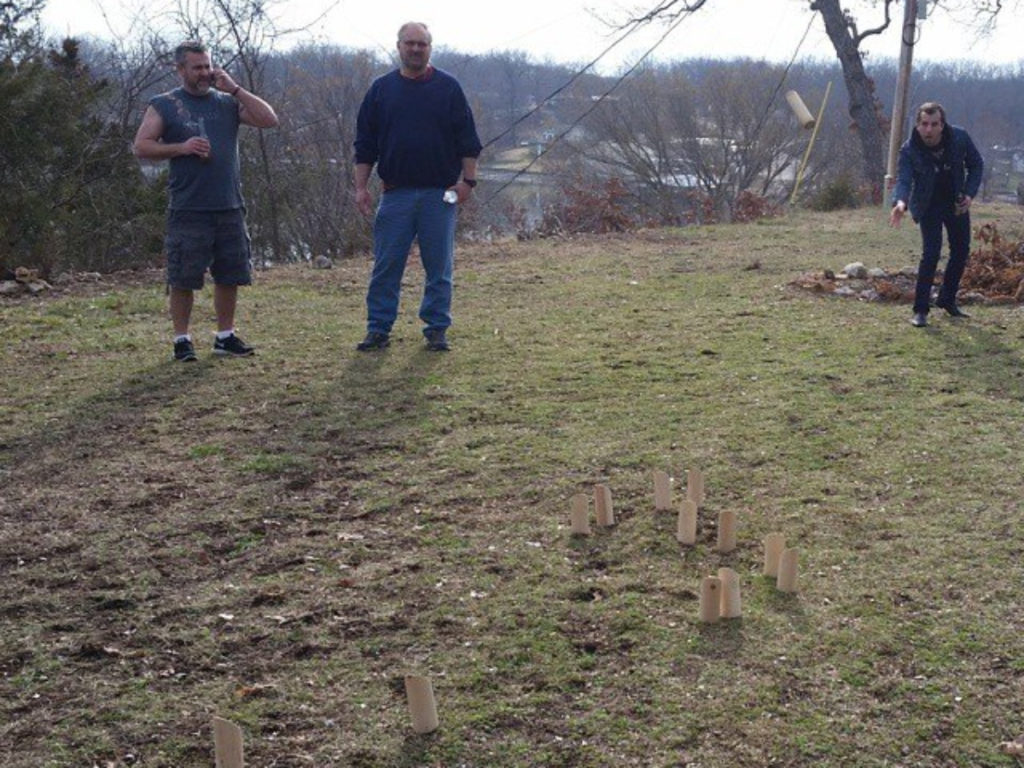
- Necromunda: Underhive (10) – This uses a basic Warhammer framework (measure movement, roll to hit, then roll to wound/possibly kill) to enact skirmish level gang battles on ruined industrial “hive worlds,” and really nails it. This is a crunchy game for sure, you can outfit your gang with just about any weapon you can think of, each with a host of special rules. The base game is very fun in its own right, but when you play a campaign the system really sings with even more special rules for everything from captured gang members to interim chaos rituals gone wrong. It’s a bit of work, but far from the most complex thing out there, and it’s all very very worth it for the narrative it builds (and the simple tactical joys of throwing a grenade in just the right spot).
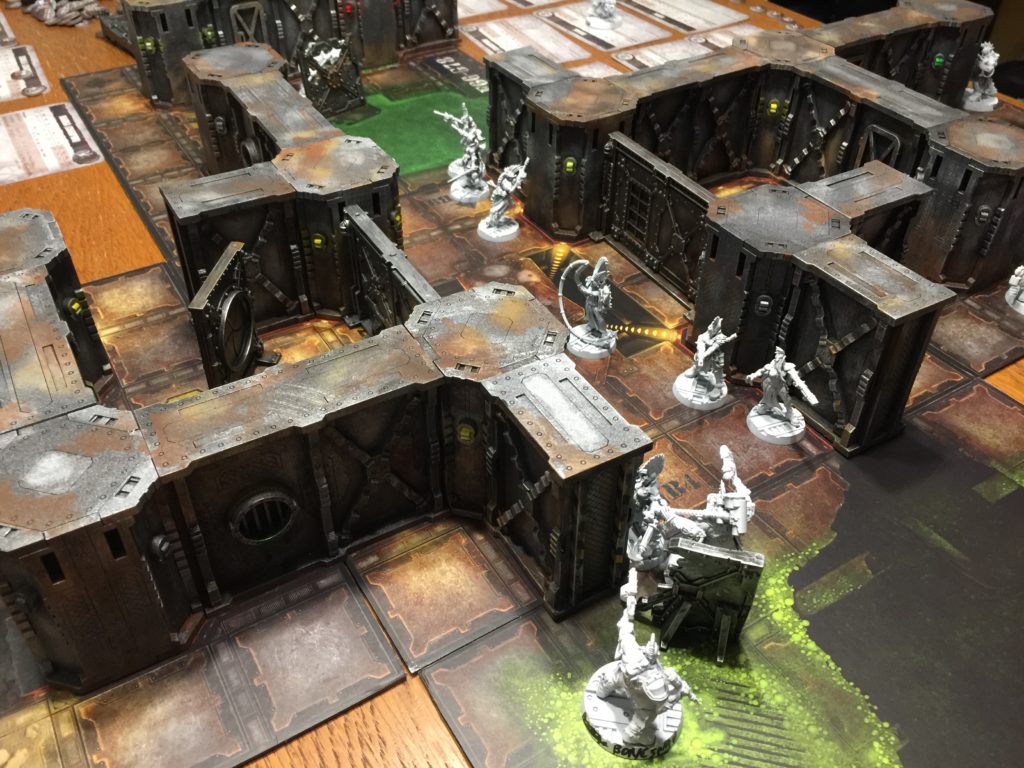
- Operation (6) – For a one-gimmick game (can you remove a small item with tweezers without touching the edges of the hole it is in), this is actually reasonably fun. It helps that it is short, and can be played with mixture of ages and still stays challenging for all involved (as long as adults go for the “hard ones.”
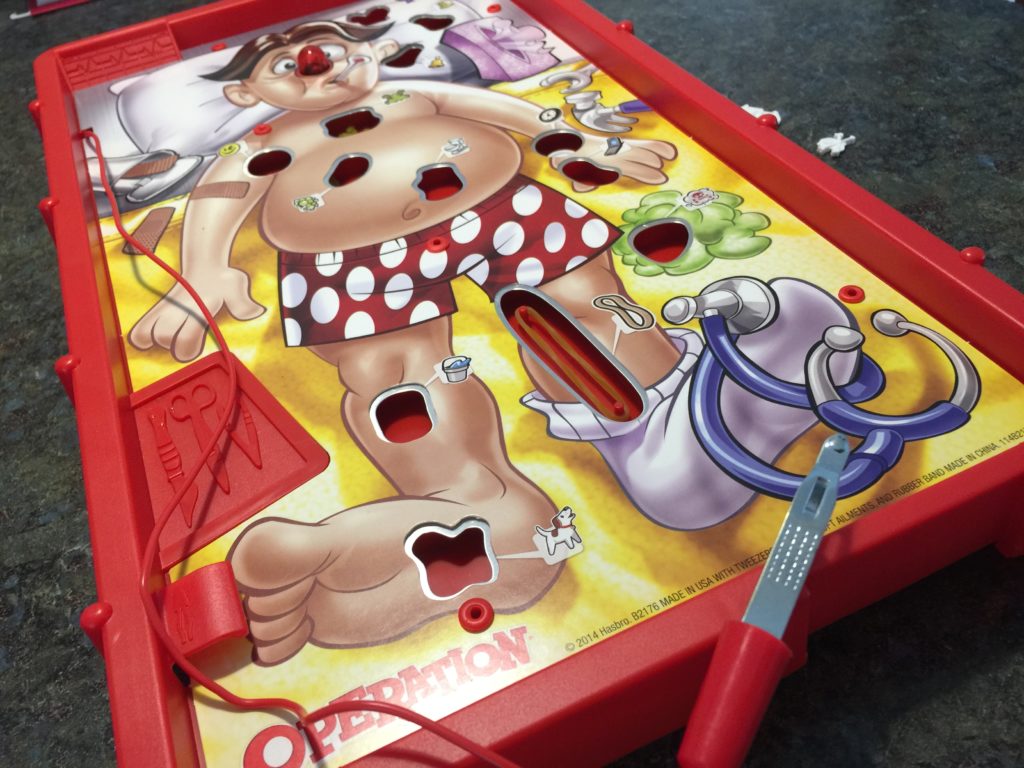
- RoboRally (10) – Granddaddy of all programming games, and still one of the best, this is a fantastic race game where you pre-program 5 actions for your robot (move forward/rotate/back up/uturn/etc) and then watch the chaos unfold as all the other player robots try to move into eachother’s spaces and people get push/pulled in unforseen directions (onto conveyer belts/pushers/lasers/etc scattered about the board). 95% of the people I have played this with hate it, but for my money, there are few better game experiences than 8 players all trying to second guess each other while secretly programming 5 moves they really hope don’t go south at the first flip of the cards. Turns are even simultaneous, making this one of the few games that can play up to 8 players with zero downtime!
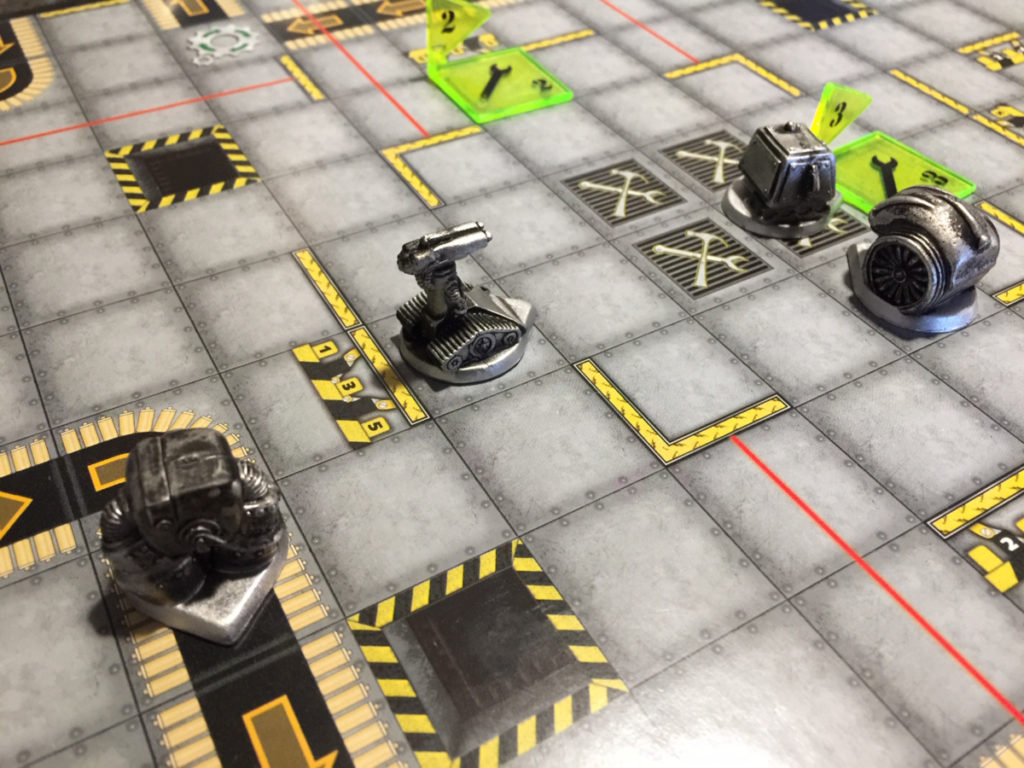
- Tales of the Arabian Nights (8.5) – First (I think?) of the story matrix games where you input your choices (which reaction to make to which encounter you have) and then turn to one of thousands of pre-written paragraphs to see what happens. It’s pretty cool how the outcome almost always matches your choices (choose to “attack” the “all powerful Efreeti”? That isn’t going to end well for you…but grovel might just work), and the story paragraphs are always pretty entertaining. It’s not really much of a game–the win condition is pretty random, but it’s always fun to break out every once in a while (also, 3 is probably the highest player count, and 2 is my preferred way to play).
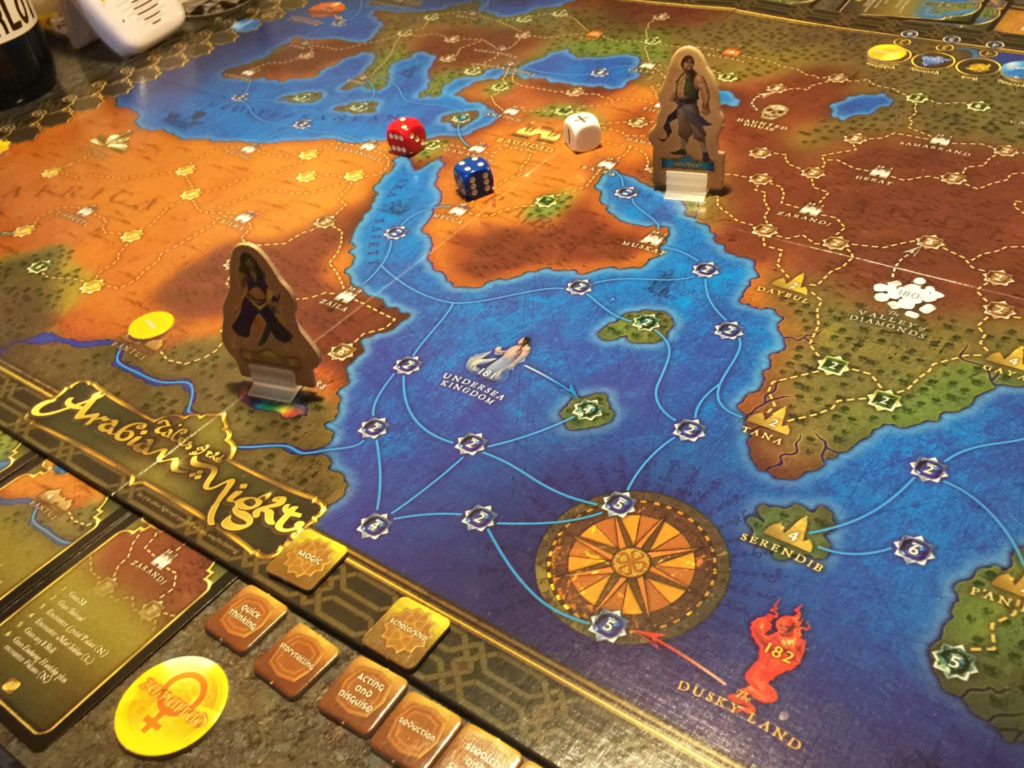
- Tara Wolf in Valley of the Kings (8.5) – There’s quite a good game hiding here where you build up allies to go into a tomb. Which ever player has the strongest team gets the treasure, first to four treasures wins. Great art, fun game play, and lots of choices made this a surprise hit!
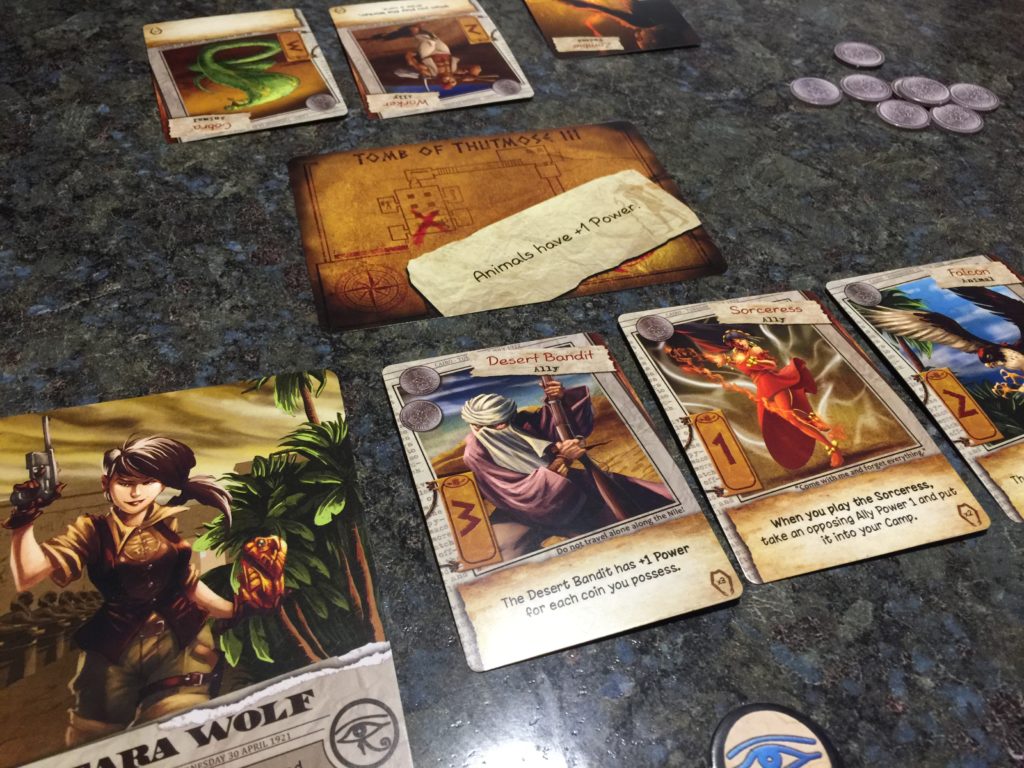
- Schotten Totten (Battleline) (10) – One of the all-time great two player games, this plays very similarly to Lost Cities, but with a good deal more strategic depth. The Schotten Totten version looks MUCH nicer (than Battleline), with the only functional difference being that the cards go from 1-9 in Schotten Totten instead of 1-10 (it doesn’t seem to affect gameplay). Improved layout aside, it’s the “just one more card before I commit” hand management game play that keeps you coming back for more time and again.
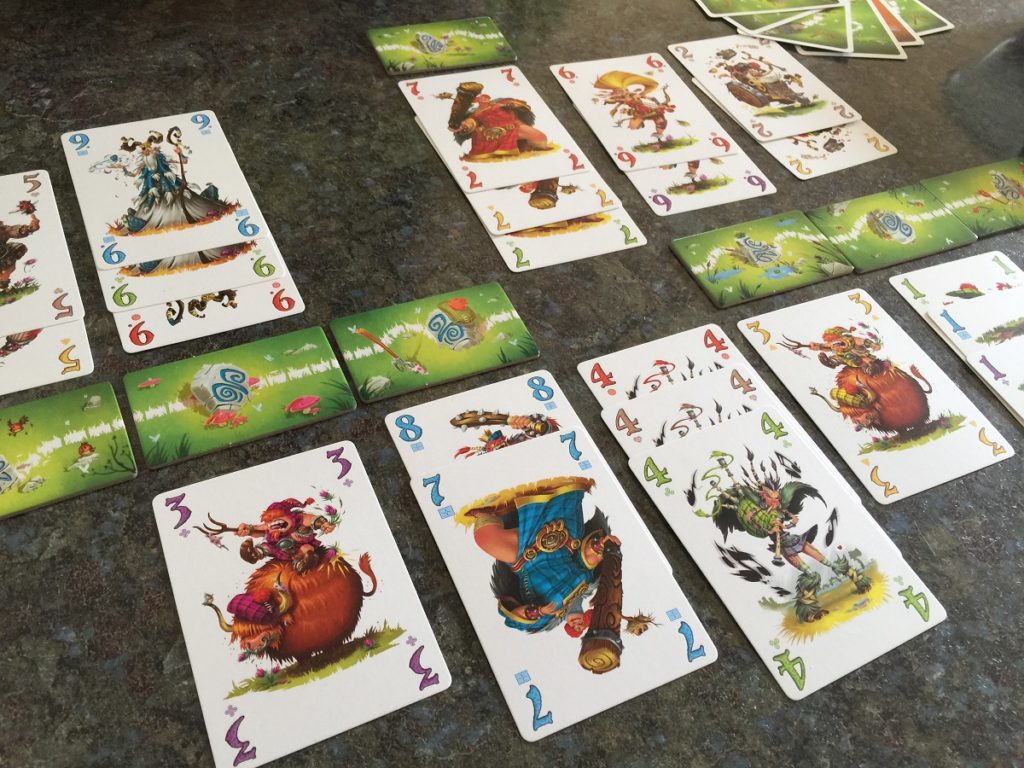
Children’s Games
- 5 Minute Marvel (5+) – Even though this “5 Minute” game adds a few wrinkles of complexity with the hero cards, you could easily leave them off making this a good game to play with even fairly young children. Core gameplay of matching symbols shown on a flipped up card as a group remains strong for all ages.
- Battleship Express (4+) – The basics of “roll number of dice shown, look for color of ship you are aiming at,” should be able to be grasped by the very young. Some of the additional rules (only hit the front two ships, etc) might be tricky, but a guiding adult should make them no problem too.
- Checkers (4+) – Even though there is no theme and it seems pretty dry, there’s enough here to entertain young ones, especially in the simple delights of jumping over an opponent’s piece, mercilessly crushing its existence from the board.
- Hop! (5+) – You will have to make the central mechanic of throwing a ring onto someone’s up-pointed finger quite a bit easier for some of the cards, but with a little tweaking (and a few second chances)(and an adult to handle the scoring), kids will have fun with this beyond how much they will love the scoring miniatures.
- Kings on the Corner (5+) – Solitaire games are quickly grasped by kids as making alternating patterns of numbers is a satisfying concept for both young and old. Being able to play with a parent gives this one some legs too.
- Mölkky (4+) – Let them stand close enough and you can play this game of knocking pins down with a wooden throwing pin with just about any age. Unfortunately there is quite a bit of math in the scoring, but for slightly older kids, that can be great practice.
- Operation (4+) – As with adults, the gimmick wears off very quickly, but kids will still have fun with this one. Little hands not used to fine detail work will probably have trouble (and lose interest quickly), but there is still fun to be had here.
Expansions
- 7 Wonders Duel: Pantheon – This adds a pretty major addition to 7 Wonders: Duel by giving a third action to be taken (which opens up its own stalling tactics): buying a god card. The God effects are quite powerful but generally the costs seem to work for them. This runs the risk of adding a few more mechanics than the game wants, but if you are feeling played out on the already deep and cutthroat base game, this is a good way to add a few more wrinkles into the mix.
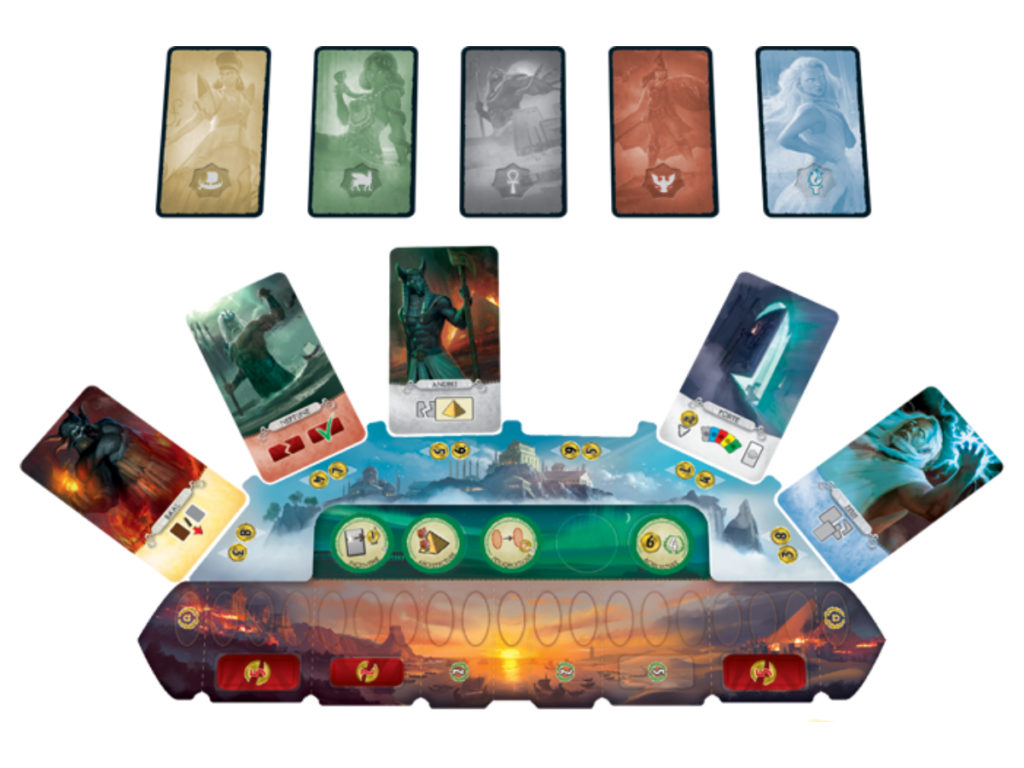
- Claustrophobia: De Profundis – Two new characters, some new monsters, and a bunch of new tiles and scenarios gives you plenty to add to your base Claustrophobia experience. The new hellhounds are a mixed bag…powerful, but sucking up an entire dice to activate them can be crippling at times. Not essential, but definitely worth picking up, the scenarios I played have all been quite good.
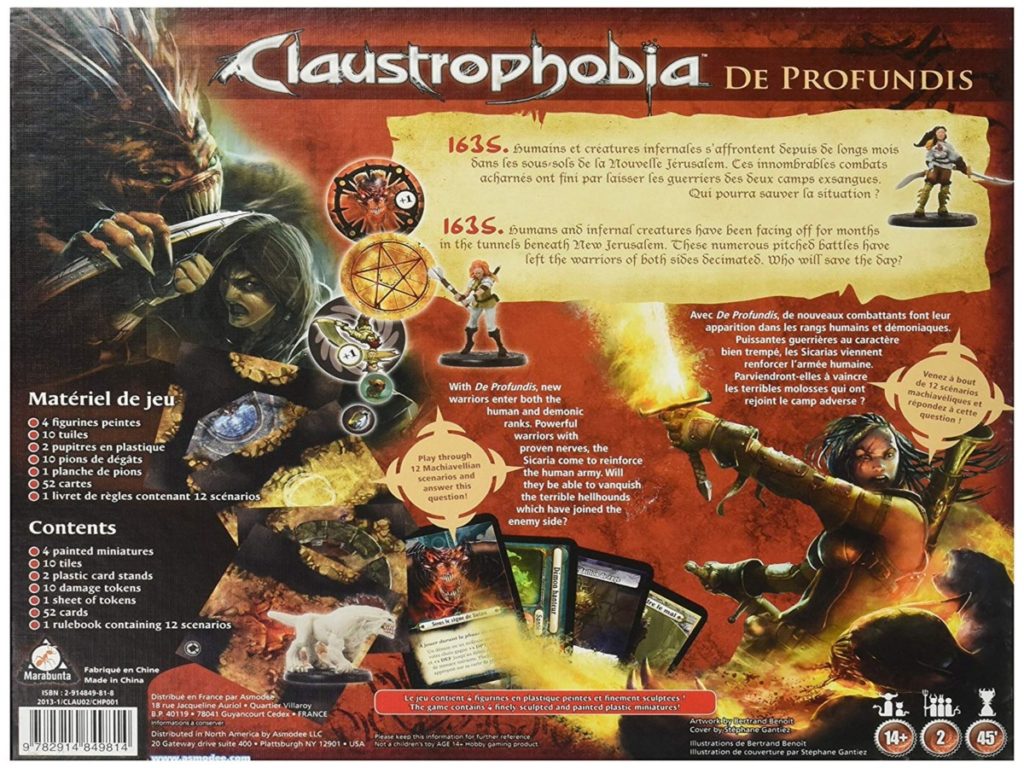
- D-Day Dice Kickstarter Small Expansions – The Flare Pouch, Distinguished Service Pack, K-Pack, and Comission Pack are all just extra cards that are pretty much completely unnecessary (and bog down gameplay with too many card options)–some of the packs are even functional reprints of other pack cards. The MGF dice are easy enough to incorporate, but I’m not convinced that they are a better option than just rolling a d6 (troop loss seems the most thematic way to represent machine gun fire). The Badges pack, however, while it makes the game a bit easier, is the clear winner here, giving a great new RBW option. If you get one, get Badges.
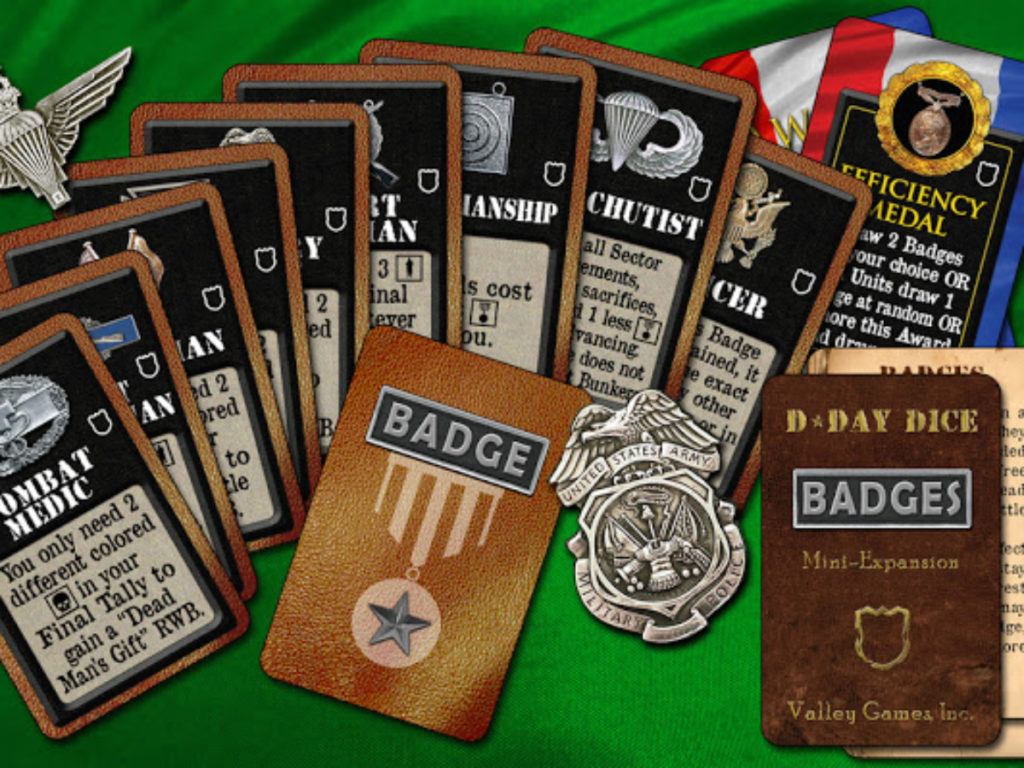
- Dungeon Twister: Prison – Even though this is technically a new base set (and comes with minis instead of cardboard standups), it is basically just a Dungeon Twister expansion. Tiles now have “arrow slits” which the Naga snake guy can move through. Only the Wizard, Cleric, and Mekanork are kept from the original game. Other new characters of note are the Telepath that chooses the other player’s combat card (not super fun for the other player), the Banshee that can push a character back (ideally into a pit trap though that’s rare to pull off), and the Backstabber that is super fast and gets a bonus in group combat. The “ranged” items are interesting, and the tiles don’t contain many surprises aside from the arrow slits. The solo rules are actually pretty good, but I don’t get much enjoyment out of solo gameplay, so they don’t do a lot for me.
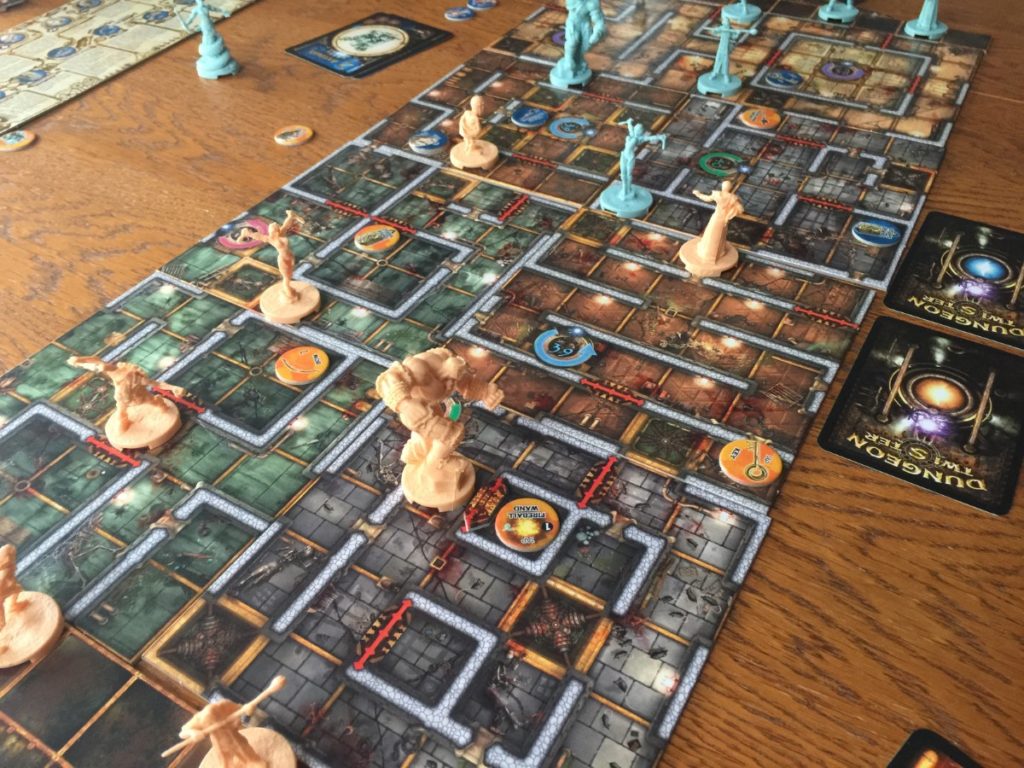
- Kingdom Builder: Harvest – This adds new farmland terrain that gives a player next to it a free build every turn. Otherwise the big change is that each board now has two DIFFERENT special tiles to pick up, bringing the total to 8, which, honestly seems like a bit much to me. Part of the allure of Kingdom Builder is how simple it is, and the four special powers already push the simplicity, adding 4 more just seems a little unnecessary.
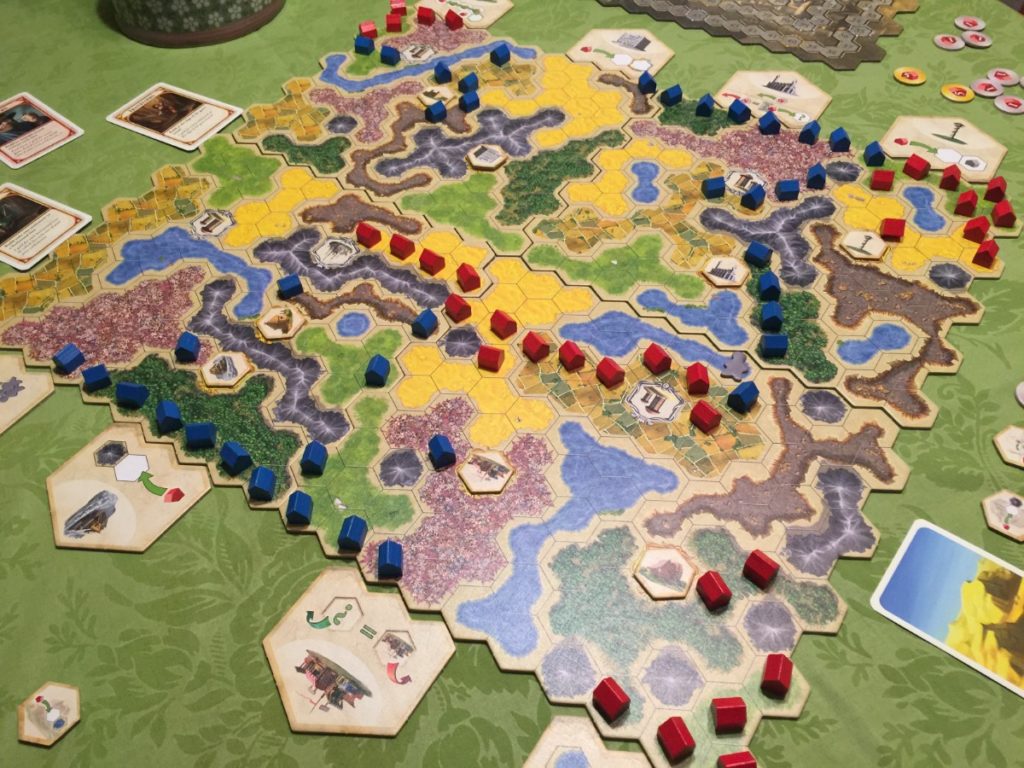
- Krosmaster: Arena – Cemetary/Fog Map – This promo tournament map only has one side, with “fog” squares that reduce your range by 1 and block line of sight if they are between you and your target. There are also 2 stairwells in the middle that I like to house rule you can move between for one MP, though this can be unbalanced depending on the teams, especially because the map already punishes ranged teams so badly. One aesthetic quibble with the 3D terrain, the gravestones are so big that they look like they would block line of sight instead of just movement like they actually do.
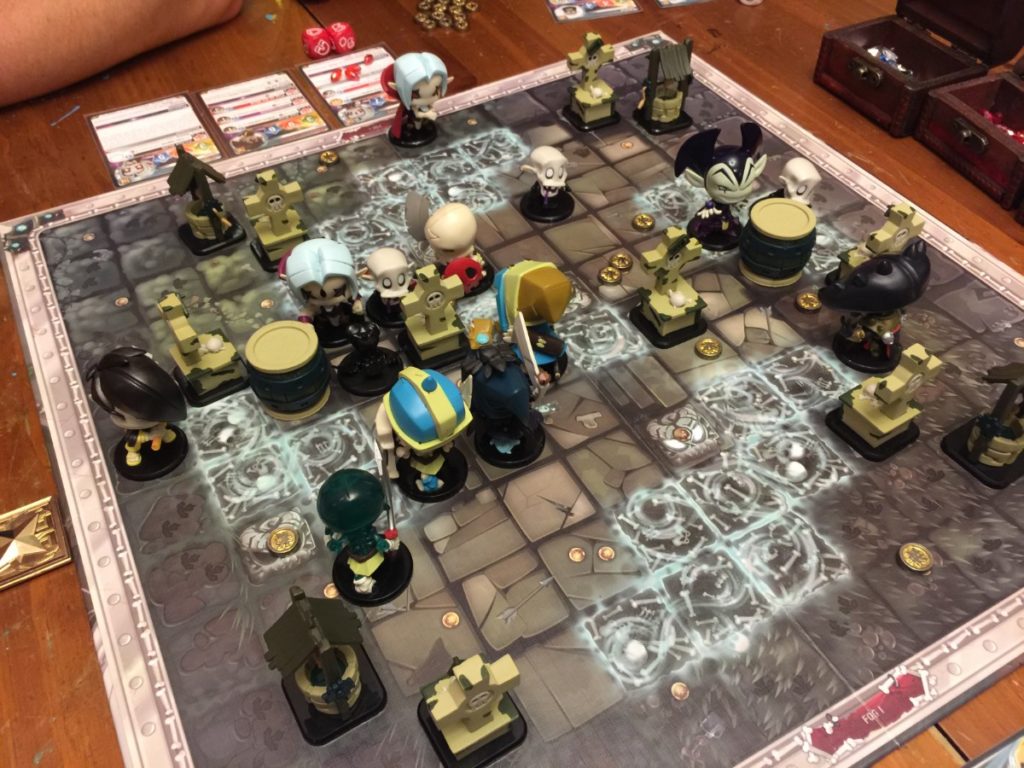
- Krosmaster: Arena – Dark Heroes – This is one of the more powerful sets of additional Krosmaster characters out there. Black Crow is almost broken due to his low cost, and really fucking annoying summoning ability. Djaul is also an auto include in many teams due to not losing GGs when destroyed, though I’ve had mixed results with his weird damage switching attack. Dark Vlad and Vampyro both seem overpowered at first, but their relative fragility makes them balanced in my opinion. Katar is very strong as well, though tough to use.
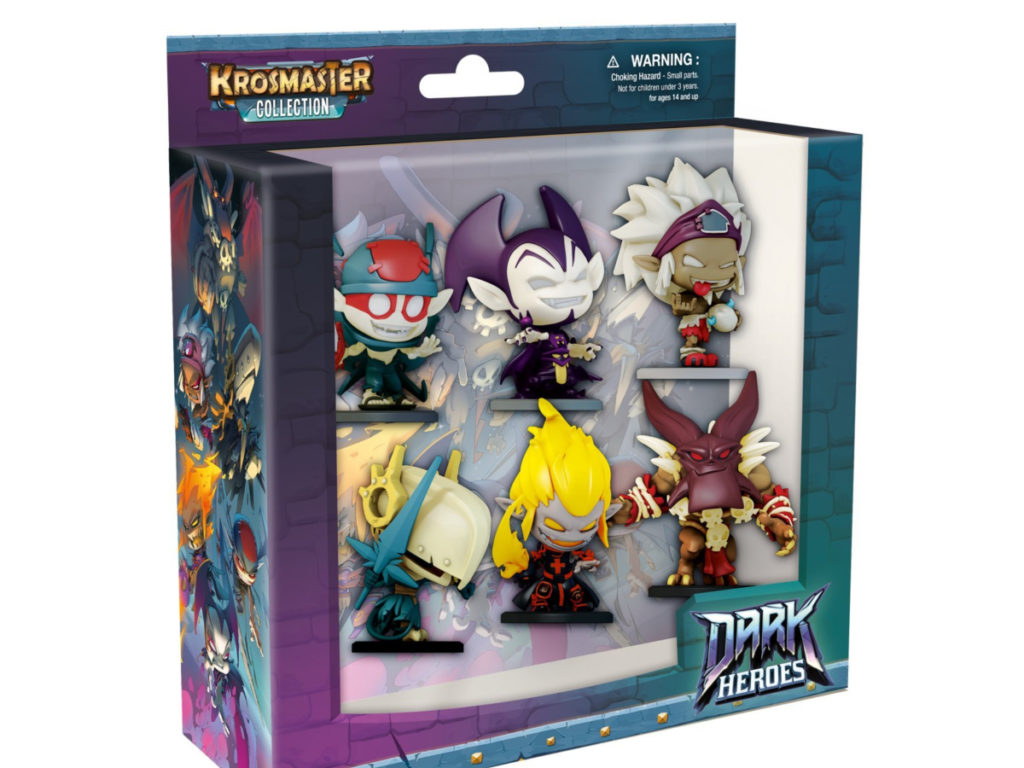
- Mage Wars Academy: The Priestess – The Priestess is not my favorite Mage to play, her healing/guard marker game just feels kind of boring and can drag the game out a bit (not a huge problem in Academy which already plays mercifully quickly). Still, if you are the kind of white bread unimaginative person that plays Clerics in D&D, maybe you’d like the Priestess…
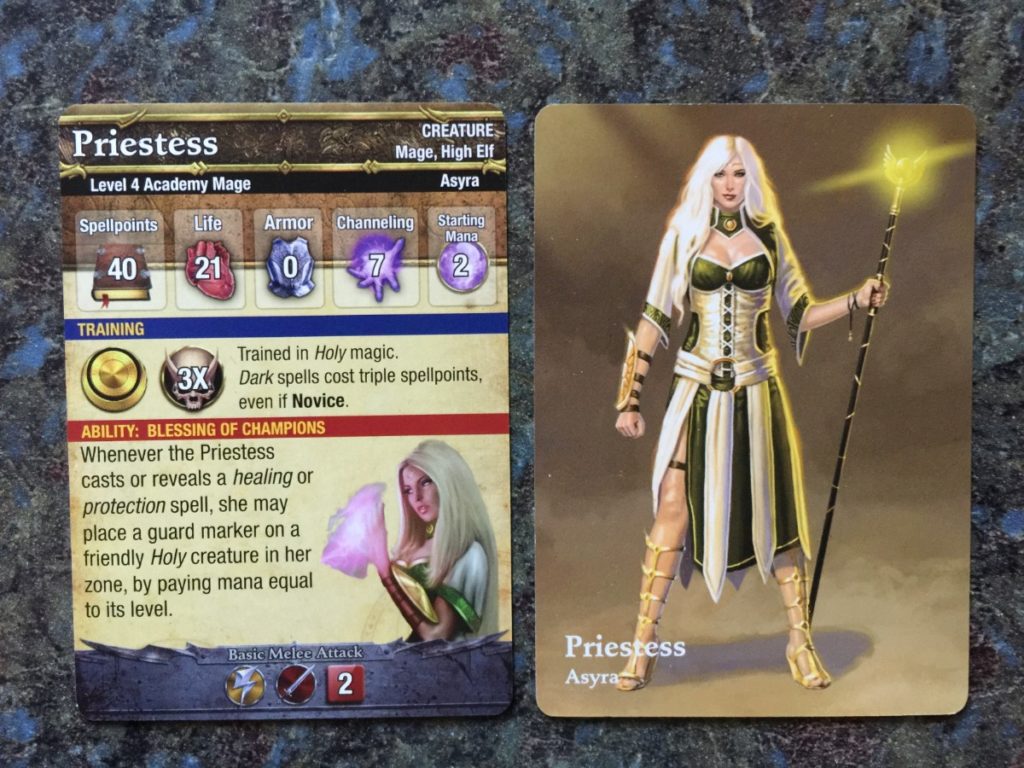
- Mage Wars Academy: The Warlock – The Warlock is definitely more my style of Mage, his “hurt myself to make cool shit” powers are super fun and thematic. And, obviously, I love all the demons and shit.
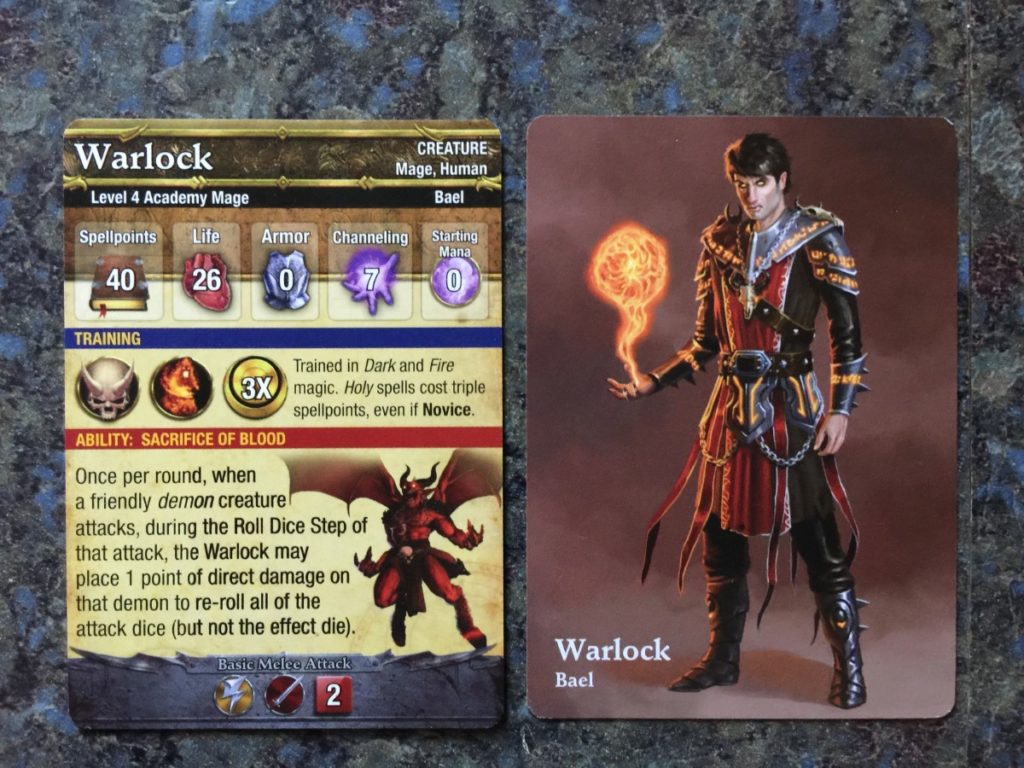
- Necromunda: Eschers – This is a tricky (and swingy) team to play well. They are pretty fragile, and do not hold up to a beating well at all, but their poison almost makes up for it, as long as the dice go your way. The models are some of the best in the game, but their whole shtick is perhaps a little too dependent on good dice rolls for them to be my number one choice.
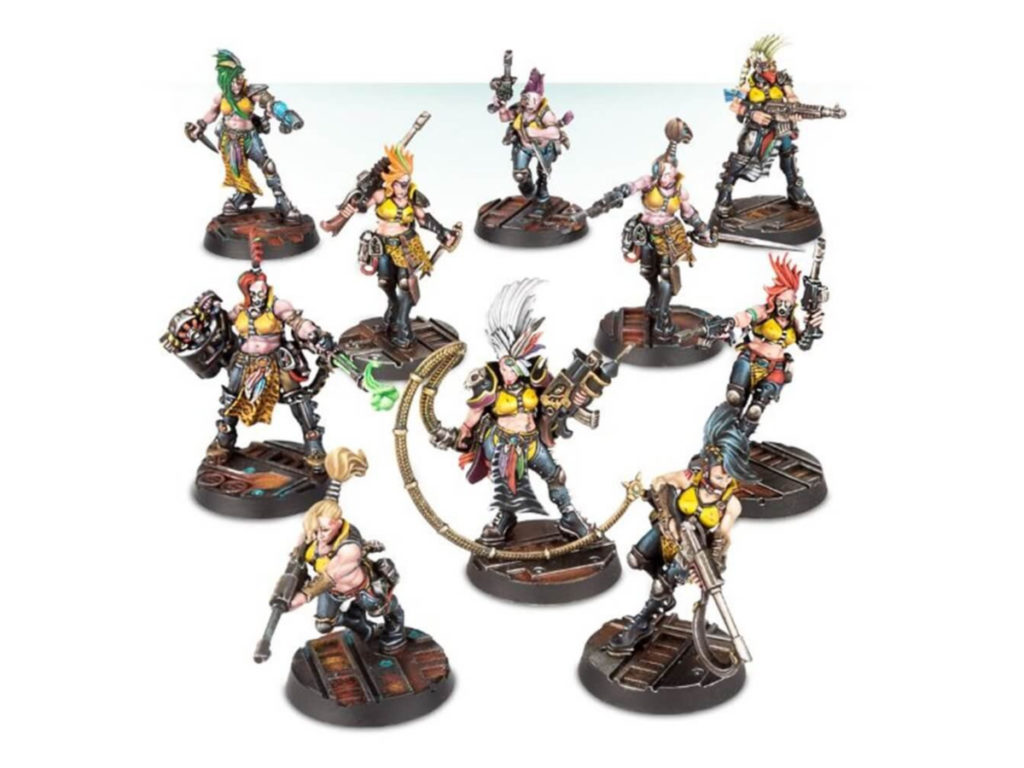
- Ticket to Ride: India – This might be my favorite TTR 2 player map. Things are reasonably tight (depending on the starting areas), and then get tighter as players try to complete mandalas (basically, connect two cities in two different ways). Even better, wilds are actually used as wilds, which makes the draw much less luck dependent than it is in Nordic Countries/Switzerland, that can find you stuck without a certain needed color turn after turn.
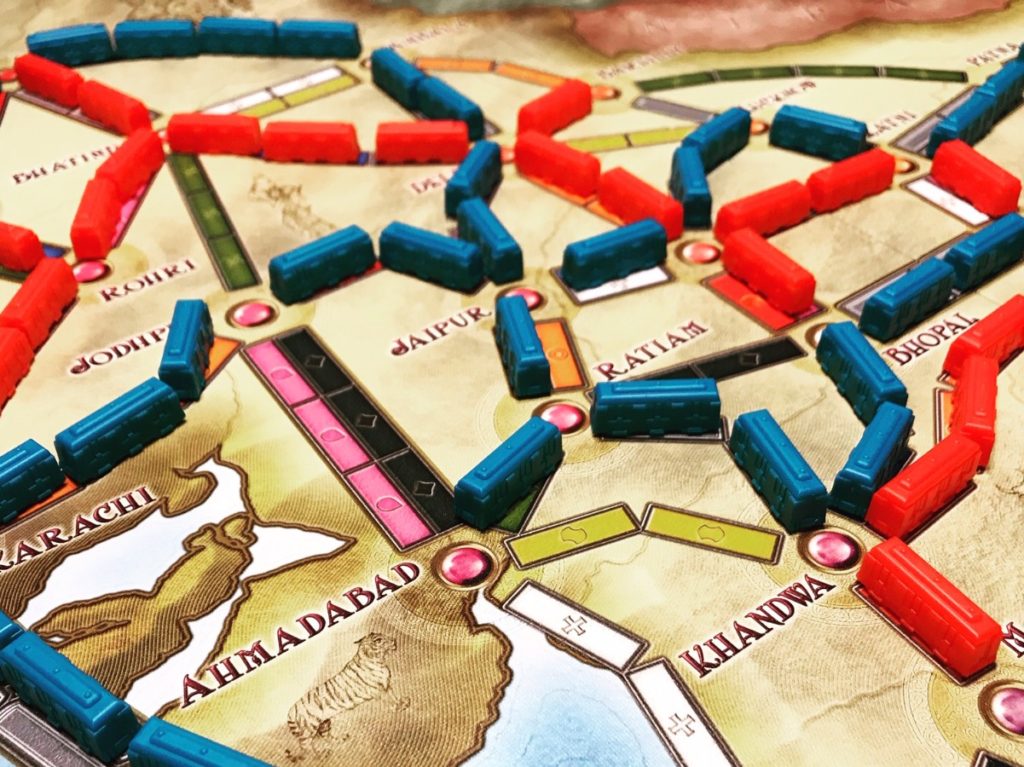

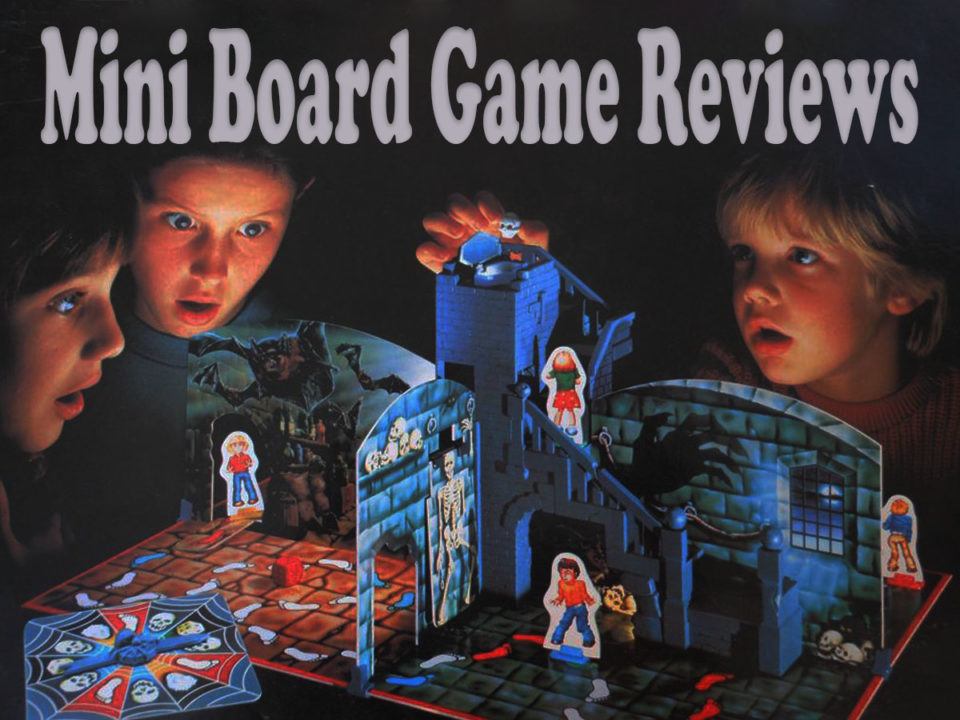
Leave A Reply